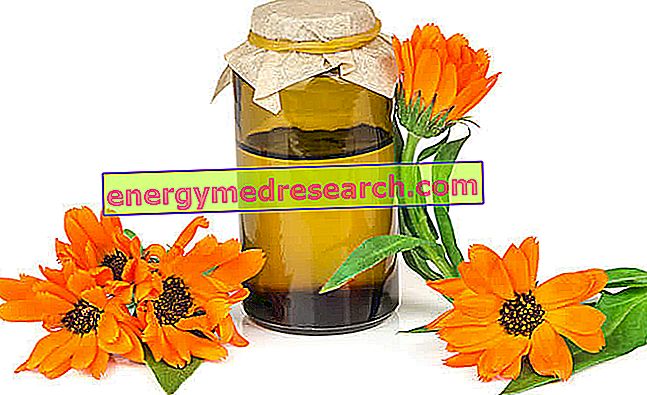What is that
Calendula oil is an oleolite obtained from the flowers of Calendula officinalis, an annual herbaceous plant belonging to the Asteraceae family.
This oil is widely used in the cosmetic and herbal fields, thanks to the numerous beneficial properties it is able to exercise at the level of the skin.

Please note
The calendula oil - a term used to indicate the oleolite obtained from the same plant - should not be confused with the essential oil of calendula, obtained by steam distillation both from the flowers and from the herbaceous parts of the same plant .
Preparation
Homemade Calendula Oil Preparation
Marigold oil is prepared by allowing the dried flowers of the plant to macerate in a vegetable oil, for a time that can vary from two to five weeks depending on the method used.
The oil used for maceration can be any vegetable oil capable of extracting the active substances contained in marigold flowers. However, the most used ones are olive oil, sunflower oil and sweet almond oil.
The world of DIY is full of recipes for the homemade preparation of marigold oil. Below, we report one of the simplest:
- Inside a glass container mix 50 grams of dried calendula flowers with 500 ml of extra virgin olive oil (the ratio drug / solvent should be 1:10).
- Once all the flowers are immersed in the oil, close the container tightly and place it in a warm place. The flowers should be left to macerate for about 30 days, taking care to mix the contents of the container about every two days. Of course, this operation must be carried out by turning the container upside down several times, which must remain well closed and must NOT be opened before the end of the maceration period.
- At the end of the maceration phase, the mixture must be filtered with the aid of a gauze, so as to remove the solid residue from the liquid phase.
- The oleolite thus obtained must be kept in dark glass containers, tightly closed and away from light.
However, in herbal medicine, in the most well-stocked perfumeries and in different online stores, you can buy ready-to-use calendula oil.
Composition and Property
Chemical Composition and Properties of Calendula Oil
Calendula oil has a rich chemical composition, determined both by the substances present in the vegetable oil used for maceration, and by the substances contained in the marigold flowers extracted from it.
More precisely, calendula oil is composed of:
- Triglycerides and fatty acids (deriving above all, but not exclusively, from the vegetable oil used for maceration);
- Triterpene derivatives;
- Carotenoids;
- Flavonoids.
The presence of these active substances gives the calendula oil numerous beneficial properties for the skin, such as:
- Eudermic properties;
- Emollient, soothing and calming properties;
- Softening properties of the skin;
- Anti-inflammatory properties;
- Healing properties.
These last properties have been confirmed by several studies conducted on calendula and its different types of extracts. In particular, the healing action and the anti-inflammatory activity are attributed to the triterpene compounds and to the carotenoids contained in the plant.
uses
Thanks to the beneficial properties performed at the skin level, calendula oil is indicated in all those situations where it is necessary to restore the normal physiological conditions of the skin.
The uses of this oil, therefore, are multiple and include the treatment of dry and chapped skin, redness and skin irritation, but not only. In fact, calendula oil can also be effectively used to reduce the symptoms caused by dermatitis and allergic reactions, such as itching, discomfort and burning.
Still, the application of calendula oil gives relief in the event of sunburn (including sunburn) and is useful for countering the discomfort, pain and itching caused by insect bites.
Furthermore, calendula oil is so delicate and well tolerated that it can also be used on children's skin to prevent and combat diaper irritation.
Finally, calendula oil is able to accelerate wound healing, for this reason, its use is of great help in the treatment of ulcers and fissures.
Please note
Calendula oil should only be used externally. Therefore, under no circumstances can it be ingested or used internally.
Side effects
Given its high tolerability, calendula oil has no significant side effects. Also the onset of allergic reactions is a decidedly rare phenomenon, although not impossible.
Contraindications
The use of calendula oil is contraindicated in case of known hypersensitivity to any of the substances contained in it.



